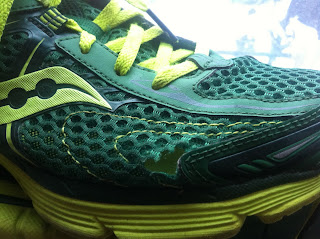I never made it back to the podiatrist. I wanted to. I wanted to ask him why the orthotics he prescribed weren't actually helping. I had already asked him, via email, why I seemed to be getting knee pain while wearing them. I also questioned why I appeared to be developing plantar fasciitis.
His response: Hi Joel. Body is adjusting to orthotics. Keep easing into them. Let me see you next week which will be one month of you wearing them. John
Dr. John Connors (not to be confused with John Connor, leader of the Human Resistance) is a very well respected expert in his field. He has helped countless athletes, including olympians, and is an avid runner himself. He has a relaxed and confident tone, is very patient and takes the time to answer all questions and explain everything. He even offered to come to give a seminar to TNT, if we were interested, covering the intricacies of foot structure, proper alignment, the impact on the other joints in your body, and the benefits of orthotics. And his favorite shoe is the Brooks Ghost 3.
 |
| The $495 custom orthotics. |
I ran that marathon in October without the insoles. In fact, the last time I used them was my last leg of the RTB Relay, weeks before. It seemed I just really didn't need them. Nor did I need another $250 doctor visit. I never went back.
Maybe my feet just got stronger and I didn't need the support of orthotics any longer. According to Dr. Connors, that's not possible. And he was pretty adamant about it. We didn't get into details, but he implied that it wasn't just foot muscles that need developing. Proper alignment was dependent on the complete structure of the foot- bones, tendons, etc... I trust that. But I hated the thought that there was nothing I could do to correct my alignment naturally. My diagnosis and conversation with the doc sounded like something straight out of a book I read recently, specifically, Born To Run.
There's a theory out there, one that I believe, suggests the more support a body part is given, the weaker it becomes. Got back pain? It's suggested to get a chair with back support. But a back supporting chair just means you have to use your back less. And if you use your back less, it's likely to get weaker. How about just doing some regular core workouts? I bet that would strengthen your back and eventually alleviate that pain. Maybe it's the same with orthotics? I like this theory, but I'm no physiologist.
What I've got is my anecdotal experience.
Consider that what began this saga- my apparent lower leg strain- was not caused by my need for proper alignment. What I really needed to do was stop over-striding. Consider the new more intense lower leg pain I was experiencing during my midsole transition was due to weakness. I was using these muscles and tendons in a new way and needed to build the strength slower than I was allowing myself (I shouldn't have done so many long runs so soon). I found that my feet were twisting slightly as I pushed off the ground. As soon as I was able to control that, the pain was no longer an issue.
So it was perhaps just a matter of proper form and conditioning.
Have a look at my shoe of choice during my transition, the Saucony Mirage, in the picture below. Equipped with plenty of cushioning, sporting flexability, and having a 4mm drop from heel to toe (compared to the normal 12mm on standard shoes), I found that after weeding out nearly a dozen shoes, this pair suited me best. 200 miles later, I started using the Saucony Kinvara, cut similarly, but weighing less.
 |
| Wear pattern confirms my midsole strike action. |
 |
| I thought a mouse nibbled it's way through. But it was my pinky toe. |
 |
| Insole shows more wear on big toe than my older ones have. |
So who is right? Well, I guess I can't exactly say that I'm right- that you can condition your way out of needing orthotics. But I can say the doctor was wrong, the orthotics weren't the solution for me. Though my orthotics did nothing for me, I do understand they have a place in the process of becoming stronger and running pain free. It should be considered that in general, we are all working desk jobs, wearing shoes that are too supportive or straining our calves and feet (ie, heels) in ways not intended by our creator. Undoing what decades of this type of lifestyle does takes time. Maybe years. Orthotics can definitely be a healthy way of giving us the ability to get off our asses and run regularly and get stronger.
Orthotics aren't a solution alone, just as shoes aren't. They are just another tool at your disposal to allow you to get fit and strong. Being active and exercising is the solution.
So my custom orthotics cost a lot of money. If you need orthotics, there's a pretty good chance you don't need them to be custom. I suggest checking out some Super Feet options. Or perhaps what Dr. Scholl's is doing these days. I get the impression my custom job isn't much different.
And I'd like to also say that I believe Dr. Connors' success and reputation speak for itself. If you've got a foot/alignment problem and needed a doctor, I'd recommend this man. Just as orthotics were not the answer here, going minimal is not going to always be the answer either. Sometimes the problem is more complicated.
That about wraps it up. Running is back to a routine thing now and my attention is focused on the Ironman.
The Complete (Mid)Sole Searching Saga
(Mid)Sole Searching: Part III